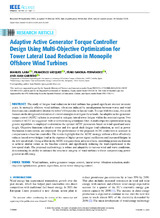Adaptive active generator torque controller design using multi-objective optimization for tower lateral load reduction in monopile offshore wind turbines
Autor
Lara, Manuel
Vázquez, Francisco
Sandua-Fernández, Iñaki
Garrido, J.
Editor
IEEE AccessFecha
2023Materia
Wind turbinesActive generator torque control
Lateral tower vibration reduction
Multiobjective optimization
Genetic algorithms
Active tower damping control
METS:
Mostrar el registro METSPREMIS:
Mostrar el registro PREMISMetadatos
Mostrar el registro completo del ítemResumen
The study of fatigue load reduction in wind turbines has gained significant interest in recent years. In monopile offshore wind turbines, vibrations induced by misalignment between waves and wind directions can considerably shorten the tower’s lifespan due to lateral loads. To cope with this issue, this work focuses on the design and evaluation of control strategies to mitigate these loads. An adaptive active generator torque control (AGTC) scheme is proposed to mitigate lateral tower fatigue within the nominal region. Two variants of AGTC are suggested: with or without using a bandpass filter. A multi-objective optimization using genetic algorithms is employed to determine the optimal AGTC parameters based on wind speed and wave height. Objective functions related to tower and low-speed shaft fatigue load reduction, as well as power fluctuation minimization, are employed. The performance of the proposed AGTC controllers is assessed in comparison to a baseline controller. The results highlight that the AGTC strategy without a filter effectively reduces lateral tower fatigue load at the expense of higher power signal oscillations and increased fatigue in the low-speed shaft. Using a filter in the AGTC mitigates these adverse effects, smoothing power oscillations to achieve similar values as the baseline control, and significantly reducing the load experienced in the low-speed shaft. The proposed methodology is robust and adaptable to various wind and wave conditions, demonstrating its ability to enhance the structural integrity of wind turbines without compromising power generation efficiency.

